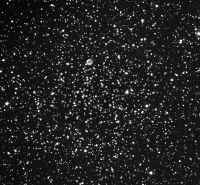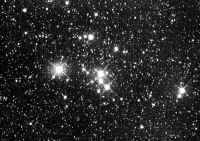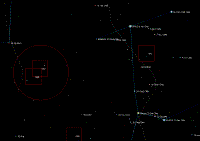M46 and M47 (open clusters in Puppis)
630: M46 image
M46, shown here, and M47 are a pair of open clusters in Puppis.
Messier discovered M46 on February 19, 1771, only three days after the first edition of his catalog was published. M46 is very rich and nearly circular, with 500 or more member stars of which about 150 range from magnitudes 8.7 to 13 and are therefore visible in typical amateur scopes. M46 is about 300 million years old, which makes it one of the older open clusters we’re looking at tonight. M46 covers about 27 arcminutes, which is just slightly smaller than the full moon.
M46 has two special features:
-
The first feature is the small planetary nebula, NGC 2438, which is visible in the photograph and appears to be a part of the cluster. Actually, it’s a foreground object, which was established by the fact that the two objects have greatly differing recession rates. This planetary nebula is visible as a fuzzy star in small and medium instruments, and can be resolved in large instruments.
-
The second special feature is that M46 has two NGC numbers assigned to it. The first, NGC 2422, was assigned based on Messier’s original incorrect recording of its position. The second, NGC 2478, was assigned by William Herschel when he re-discovered M46 independently.
640: M47 image
Hodierna discovered M47 before 1654. Messier independently rediscovered M47 on February 19, 1771, but recorded the position incorrectly, which resulted in M47 being a “missing Messier Object” until Oswald Thomas discovered and corrected Messier’s error in 1934. It is a measure of the respect accorded to Messier that this incorrect position was repeated in numerous sources for more than 150 years, although there was clearly no object at the position Messier reported.
M47 is brighter and coarser than its companion M46. At magnitude 5.2, M47 is visible naked-eye as a dim nebulosity under excellent conditions, although I’ve never seen it without optical aid. M47 is a coarse cluster, containing about 50 stars over an area about the diameter of the full moon. The brightest star is magnitude 5.7, and with binoculars M47 looks like a dim version of the Pleiades. At about 78 million years old, this is a young cluster.
650: M46 and M47 with Binoculars
The Astronomical League rates M46 and M47 as “Easy” objects with 7X50 binoculars, which indeed they are from Bullington. Finding M46 and M47 with binoculars is pretty easy. Locate Sirius and Wezen in Canis Major. Sirius is so bright that it makes everything else except Jupiter look dim, but even so Wezen, at magnitude 1.84 is a prominent guide star. Use the Sirius-Wezen line as the baseline of an imaginary equilateral triangle, with its apex pointing away from Orion and in the general direction of Monoceros and Canis Major. Put your binocular in the general area of the apex, where M46 and M47 will be prominent as nebulosities.
It’s possible to get M46 and M47 into the eyepiece of your scope by star hopping, but I find it easier to use the same method that I use for binoculars. Put your Telrad in the general area of the apex of the equilateral triangle of which the Sirius-Wezen line forms the base, and you should be able to see M46 and M47 in your optical finder. If not, it shouldn’t take more than a few seconds of panning around to find them. They’re quite clear in our 8X50 optical finder, and I suspect they’d show up nearly as well in a 6X30.
Once you have M46 and M47 centered in your optical finder, use a low power eyepiece to view them. If you have an eyepiece that provides a true field of about 1.8 degrees or more, you can get M46 and M47 into the same field of view.


